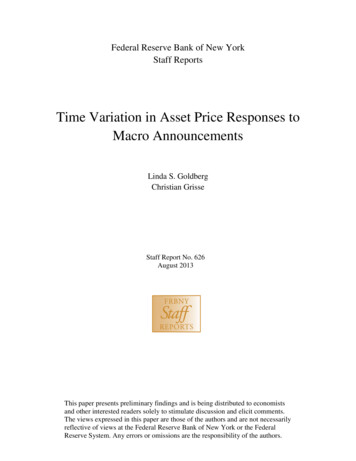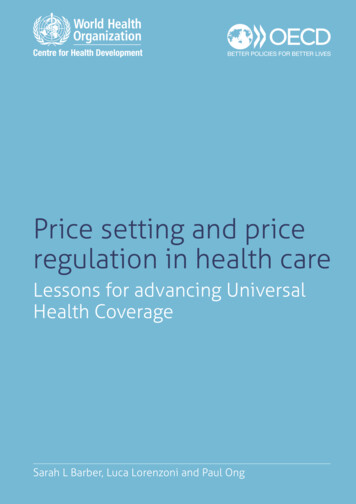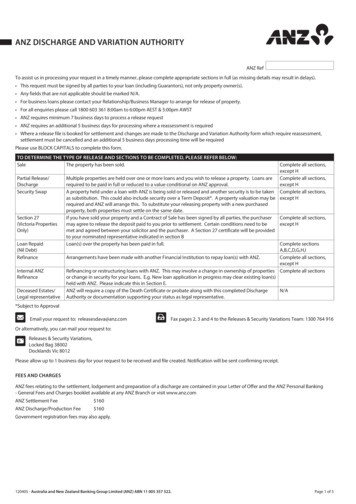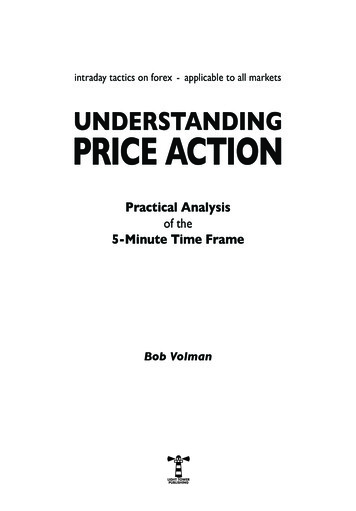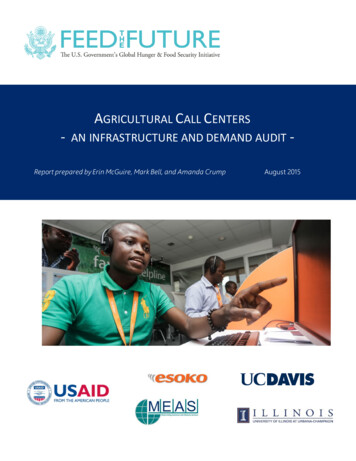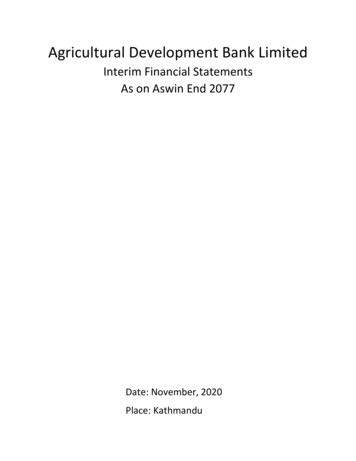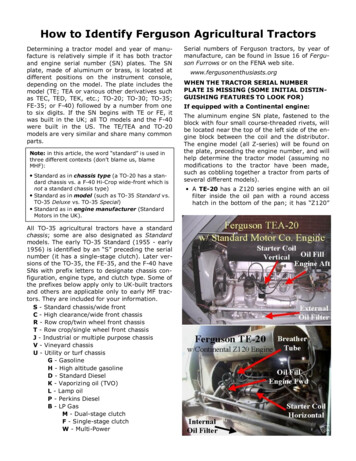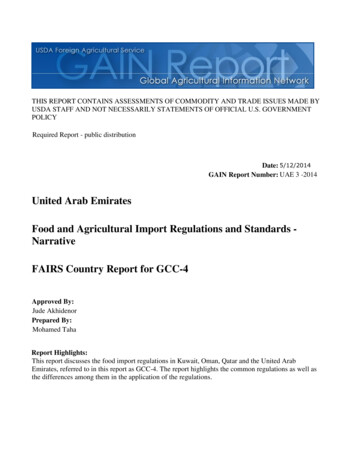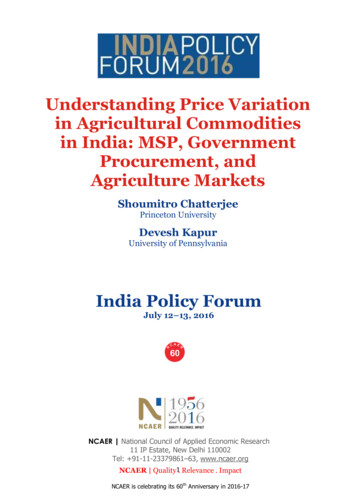
Transcription
Understanding Price Variationin Agricultural Commoditiesin India: MSP, GovernmentProcurement, andAgriculture MarketsShoumitro ChatterjeePrinceton UniversityDevesh KapurUniversity of PennsylvaniaIndia Policy ForumJuly 12–13, 2016NCAER National Council of Applied Economic Research11 IP Estate, New Delhi 110002Tel: 91-11-23379861–63, www.ncaer.orgNCAER Quality1. Relevance . ImpactNCAER is celebrating its 60th Anniversary in 2016-17
2The findings, interpretations, and conclusions expressed are those of the authors and do notnecessarily reflect the views of the Governing Body or Management of NCAER.
Understanding Price Variationin Agricultural Commoditiesin India: MSP, GovernmentProcurement, andAgriculture Markets*Shoumitro ChatterjeePrinceton UniversityDevesh KapurUniversity of PennsylvaniaIndia Policy ForumJuly 12–13, 2016AbstractSpatial variations in real prices of agricultural commodities in India arelarge. The paper first describes the evolution of agricultural commodity markets inIndia and provides some descriptive statistics. Next it documents the spatialvariation in wholesale prices of the principal cereal crops (rice and wheat) in allAPMC mandis across India and within each state. It further shows persistence inthis variation over time. Using a Shapley-Shorrocks decomposition, the paperanalyzes the relative contributions of different factors in explaining this pricevariation. It then examines the effects of two key government interventions inagriculture markets, the Minimum Support Price (MSP) program andprocurement by government agencies, and the effects of the monopsony power ofmandis on price formation in agriculture output markets. The paper concludeswith some thoughts on future research directions.JEL Classification: D43, D45, O1, Q11, Q12, Q13, Q18Keywords: Agriculture, Market Imperfection, Economic Development*Preliminary draft. Please do not circulate beyond the discussion at NCAER India Policy Forum2016, for which this paper has been prepared.Chatterjee: sc20@princeton.edu Kapur: dkapur@sas.upenn.edu .The authors would like to thank Amarsingh Gawande and Beeban Rai for excellent researchassistance.i
Shoumitro Chatterjee and Devesh Kapur 1Understanding Price Variation in AgriculturalCommodities in India: MSP, GovernmentProcurement, and Agriculture MarketsShoumitro Chatterjee and Devesh Kapur1. IntroductionA quarter century after India’s historic shift to a more market oriented economy,with industrial delicensing, trade liberalization, and (more limited) reforms in factormarkets, one sector continues to be plagued by a curious combination of severelyintrusive government regulations in both factor and product markets, an arbitrarypolicy and regulatory environment and low public investments where needed.Unfortunately, that sector – agriculture – not only accounts for the livelihoods of themajority of India’s population, but is also critical to multiple long-term challenges facingthe country from food security to natural resource sustainability, especially soil andwater.The challenges facing Indian agriculture and its tens of millions of farmers havebeen well recognized, whether the media attention and hand wringing on farmersuicides, the reports of the National Commission on Farmers (led by M. S. Swaminathan)or official government documents, such as the Economic Survey, 2016. While there hasbeen much attention to subsidies in factor markets in agriculture (especially water,electricity and fertilizers) because of their high fiscal costs, with the exception of thepublic distribution system, there has been relatively less attention on how governmentactions shape product markets in Indian agriculture.In this paper we focus on how (a) government interventions in support pricesand procurement and (b) regulation and physical location of wholesale agriculturecommodity markets affects price variation across space. We focus on rice and wheatwhich together account for about three-fourths of foodgrain output in India (coarsegrains and pulses account for the remainder). We find large variances in prices ofagricultural commodities across the country. Real wholesale prices across wholesalemarkets have an average standard deviation of 0.18, much higher than the US and alsomany developing countries like Philippines. Moreover, it has been high each year of thelast decade. This is especially puzzling in light of the huge increases in cellphonepenetration and a massive expansion of the rural road network during this period.1Information frictions can impede trade in a manner distinct from trade costs (Jensen2007) and greater connectivity should (in principle) reduce spatial price differences aswas the case between regions connected by railroads following railroad construction incolonial India (Donaldson 2015).The large variance in prices is important to understand because it implies notonly that consumers pay different prices at different locations for the same product(unless subsidized by schemes such as the PDS) but producers get different pricesCellphone penetration in India increased from 78 million in 2005 to more than 900 million in2014. Between 2005-06 and 2013-14 under the Pradhan Mantri Gram Sadak Yojana (PMGSY)the government released nearly Rs, 100,000 crores for rural roads construction. In this period332,835 km of rural roads connecting around 80,000 rural habitations were constructed.Source: Ministry of Rural Development Annual Report 2013-14: 49-50.1
2 India Policy Forum 2016depending on where they are physically situated. This issue has been largely neglectedin the contentious debates on agriculture policy which have largely focused on subsidiesin agriculture input markets and price support for agriculture outputs (with somenotable exceptions). There have also been public discussions on large price wedgesbetween farm-gate and retail prices (a discussion we get to later).These discussions have largely ignored agriculture output markets, which as wedemonstrate is evident in the severe underinvestment in the physical infrastructure ofmandis, the regulatory framework and their internal governance. A rural road doesonly so much for a farmer if there is no well-functioning market in reasonableproximity. Despite attempts at regulatory reform there is a great degree of hysteresisand path dependence in how agriculture markets function in India today. For instance,agriculture market liberalization in Bihar and Andhra Pradesh has not lead to muchprivate investment in output markets. In order to gauge the potential impact of reformswe must first understand the underlying mechanisms. This paper is a modest beginningand focuses on two aspects: (a) Government interventions in the output market, namelyprocurement and support prices. Given that the government does not uniformlyprocure across space and commodities what are the implications for output prices ofthe principal cereals, rice and wheat and (b) what is the source and implications onmarket prices of the market power enjoyed by the agricultural mandis? A key strengthof this paper is its all-India scope (spanning the 16 largest states) which to ourknowledge is the first such attempt.The remainder of the paper is organized as follows. Section 2 describes theevolution of agricultural output markets and their regulation in India. Section 3,discusses the data. The subsequent analytical section of the paper begins with somedescriptive statistics of agricultural market infrastructure in India (section 4(i))followed by an analysis of price variation in the principal cereal crops, rice and wheat(section 4(ii)). Section 4(iii), examines the effects of two key government interventionsin agriculture markets, the Minimum Support Price (MSP) program and procurement bygovernment agencies. Section 4(iv) has a discussion of price formation in agricultureoutput markets where mandis enjoy market power locally and section 5 concludes withsome thoughts on future research directions.2. History of Agriculture Markets in IndiaThe roots of the regulatory regime in agriculture markets in India go back to theRoyal Commission on Agriculture (1928) which recommended enactment of marketlegislation to create common standards to measure the quality of produce and curbrampant malpractices by private market operators (especially on weights andmeasures) and help farmers realize better returns.As with other aspects of economic life in post-independent India, agriculturemarkets were also subject to a more onerous regulatory regime. These regulations,many of which derive from the Essential Commodities Act 1955, include controls onprivate storage, transport, processing, exports, imports, credit access, and marketinfrastructure development. The rationale for these regulations was ensuring areasonable income for farmers and access to food commodities by consumers ataffordable prices.
Shoumitro Chatterjee and Devesh Kapur 3Since agriculture is a state subject, the regulation of wholesale agriculturemarkets has been governed by various state specific Agricultural Produce MarketingActs which date back to the 1960s. These Acts empowered state governments to notifythe commodities and designate market areas where the regulated trade could takeplace. The Acts also provided for the formation of agricultural produce marketcommittees (APMC) tasked with operating these markets. Prices are discovered throughwhat in principle is an open auction. Critically, once an area was declared a market areaand falls under the jurisdiction of a Market Committee, no person or agency wasallowed freely to carry on wholesale marketing activities elsewhere. Not only did thegovernment issue licenses to trade in these markets but also the licenses were state andmandi specific. As the GOI’s own website puts it: "Once a particular area is declared as amarket area and falls under the jurisdiction of a Market Committee, no person or agencyis allowed to freely carry on wholesale marketing activities. APMC Acts provide thatfirst sale in the notified agricultural commodities produced in the region such as cereals,pulses, edible oilseed, fruits and vegetables and even chicken, goat, sheep, sugar, fishetc., can be conducted only under the aegis of the APMC, through its licensedcommission agents, and subject to payment of various taxes and fee. The producers ofagricultural products are thus forced to do their first sale in these markets."2The APMC Acts were just one among a plethora of laws promulgated by theCentre and State governments, all aimed at regulating the conduct of marketfunctionaries and processing units.3 The result was to put up multiple barriersrestricting competition among agriculture commodity buyers as well as increase thetransaction cost for marketing operations. The Task force on EmploymentOpportunities of the Planning Commission in its report in 2001 had observed, “TheEssential Commodities Act is a central legislation which provides an umbrella underwhich the States are enabled to impose all kinds of restrictions on the storage; transportand processing of agricultural produce. These controls were traditionally justified onthe ground that they were necessary to control hoarding and other type of speculativeactivity, but the fact is that they do not work in times of genuine scarcity and they arenot needed in normal times. Besides, they are typically misused by lower level ofadministration and become an instrument of harassment and corruption”.The APMC Acts were co-joined with another intervention, namely the MinimumSupport Price (MSP) for foodgrains. These are a sub-set of numerous price supportschemes (PSS) for multiple agriculture commodities (for 23 crops in 2015) and inprinciple function as options for farmers.4 The floor prices that MSPs are supposed toset have little impact unless the state backs it by being prepared to purchase le Agricultural Produce Market Committee (APMC).3Theseinclude the Prevention of Food Adulteration Act, 1954, Essential Commodities Act, 1955,Standards of Weights & Measurement Act, 1976, Prevention of Black Marketing & Maintenanceof Supply of Essential Commodities Act, 1980, Consumer Protection Act, 1986, Bureau of IndianStandards Act, 1986, Agriculture Produce (Grading & Marketing) Act, 1986.4 Each year before the harvest (rarely before planting), the GOI announces the minimumsupport prices (MSP) for procurement on the basis of the recommendation of the Commissionof Agricultural Costs and Prices (CACP), which is supposed to take into consideration the cost ofvarious agricultural inputs and then add a reasonable margin for the farmers to come up with aMSP. In practice the final figure is also shaped by political and fiscal considerations.
4 India Policy Forum 2016amounts at the MSP.5 To facilitate procurement of food grains, the FCI and various stategovernments’ agencies have established a large number of purchase centers at variousmandis and key points, whose numbers and locations are decided by the StateGovernments. The establishment of a large network of markets has contributed to adoubling of the marketed surplus to output ratio since independence (from one-third totwo-thirds). For instance, during 2015-16 more than 20,000 procurement centers wereoperated for wheat procurement and 44,000 for paddy across India. However, there issubstantial geographic variation in procurement of produce, which has implication onmarket prices. The reason for this variation in procurement is unclear to us at presentand remains a puzzle. However, we are trying to interview officials at the FCI tounderstand the reason and is part of the research question.Yet despite the seemingly large number of rural markets, post-harvest distresssales, absence of grading and packaging at the farm level and inter-locking credit andcommodity markets continue to be common place. The severe underinvestment inmarket infrastructure has been well recognized (Chand 2012). A st
Understanding Price Variation in Agricultural Commodities in India: MSP, Government Procurement, and Agriculture Markets Shoumitro Chatterjee Princeton University Devesh Kapur University of Pennsylvania India Policy Forum July 12–13, 2016 NCAER National Council of Applied Economic Research 11 IP Estate, New Delhi 110002 Tel: 91-11-23379861–63, www.ncaer.org NCAER Quality . Relevance .
